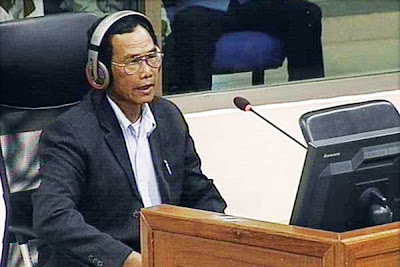 |
| Norng Sophang, a former telegraph and code operator who testified at the Khmer Rouge tribunal. Photograph: ECCC/POOL |
Joseph Freeman
The Phnom Penh Post
“The Khmer Rouge had a slogan: ‘Secrecy is the key to victory. High secrecy, long survival.’”
Khmer
Rouge leaders and cadres were so paranoid about messages being
intercepted that communications took place on special frequencies and
secret signals were exchanged between the sender and receiver before
transmission could occur, said Norng Sophang, a former telegraph and
code operator who testified at the Khmer Rouge tribunal yesterday.
Sophang, a 60-year-old retired
teacher, spent much of his day on the stand delving into the nitty
gritty of the intricate system.
In response to questions posed
by senior assistant to the international co-prosecutor Tarik Abdulhak,
he told the court that senior leaders would send transmissions to the
zones using a special technique, and that telegrams were given an extra
wrinkle of encryption depending on the level of classification.
A recipient trying to decipher some of the most sensitive documents, for example, would have to work through a few steps.
“There are three layers for the
process of encryption in order to make the message final,” Sophang said.
“The most confidential messages were in relation to the journeys made
by the cadres … and secondly, it was the internal affairs, that is, what
happened in various bases, that would fall under this category as
well.”
At his job, Sophang taught
others how to use and understand one of the more basic methods, which
involved a 100-cell table filled with letters and numbers.
To unlock the numerical part of a
telegram using the table, the reader would have to know that each
character in the table translates corresponding figures in the rows and
columns.
“For instance, for number nine,
that is number 1 [on the vertical column], and on the horizontal line it
is number 8, so 18 represents number nine.”
Numbers, Sophang added, could
describe offices and even people. Son Sen, Democratic Kampuchea’s
defence minister, was referred to simply as 47.
“And in relation to an open message, as in unencrypted, there were very, very few,” Sophang said.
Coding and ambiguous language
was another part of the cloak-and-dagger nature of the Khmer Rouge, said
Youk Chhang, head of the Documentation Center of Cambodia, which has
collected thousands of telegrams from the regime.
Seemingly straightforward telegrams are marked by idiomatic phrasing and a lack of clear reference.
One of their strangest
qualities, though, is a heavy reliance on adjectives and adverbs:
“felicitously welcome the second anniversary of national independence”;
“the super-fantastic 17th of April”; and “let’s congratulate
super-excellently the glorious Communist Party of Kampuchea”.
The act of concealment was central to the operation and thinking of Democratic Kampuchea, Youk said. “The Khmer Rouge had a slogan: ‘Secrecy is the key to victory. High secrecy, long survival.’”

No comments:
Post a Comment